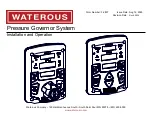
Chapter 12
Page no. 128
12-imgac.fm
GE Healthcare
Senographe DS Acquisition System
Revision 1
Operator Manual 5307907-3-S-1EN
Image Acquisition Procedure
4-3
AOP
configuration at installation
4-3-1
Classic Tables versus Profile Tables
For each AOP mode, two sets of optimized exposure parameters are available on the Senographe.
These are called Profile Tables and Classic Tables.
The Profile Tables have been created to provide an additional way to manage the trade-off between
image quality and patient dose by changing some of the selections of exposure parameters for particular
breast thickness and composition combinations. The changes in exposure parameter selection are
expected to affect Contrast to Noise Ratio (CNR) and Average Glandular Dose (AGD).
It is important to understand that any improvement in CNR is done at the cost of an increase in AGD and
vice versa; a reduction in AGD yields a diminished CNR. If the site operates in the Contrast mode, and
the emphasis is on imaging mid-sized breasts, Classic Tables may be preferred. If the emphasis is on
imaging larger breasts, Profile Tables may be preferred. If the site operates in the Standard or Dose
mode, and the emphasis is on imaging larger breasts, Profile Tables may be preferred. It is the radiolo-
gist's responsibility to make the choice between configuring Profile Tables or Classic Tables.
4-3-2
Configuration process
At installation, one table or the other must be configured for each of the three AOP modes. The desired
configuration must be set with the Field Engineer. Note that this choice may be constrained due to regu-
lations in force in certain countries. These are explained in the Service Manual, and must be discussed
with the Field Engineer.
Once the Senographe is installed, should you need to know which of the tables have been set; please
contact your Field Engineer.
4-4
Use of markers in AOP Mode
The algorithm used in AOP mode searches for the most dense part of the breast, and uses this as a ref-
erence in its calculations. It is therefore important to avoid the presence of dense objects in the area
used by the algorithm.
When using AOP mode, do not place large markers such as view name markers in the area used by the
AOP algorithm. They may be used anywhere outside this area. Small markers with an area no greater
than 2 mm
2
, such as BB markers up to 1.6 mm in diameter, may be used as required.
CAUTION
Do not use any radio-opaque markers other than BB markers within the AOP ROI.
BB markers having diameters up to and including 1.6 mm diameter may be used. Larger
markers will affect the calculation of tissue density, which may lead to a degraded image.
In contact mode exposures using AOP, the region used to iden-
tify the densest part of the breast has an area of 160 mm by
140 mm, is adjacent to the chest wall side and, is centered on the
image receptor (the shaded area in the diagram).
No large markers in shaded area
160 mm
AOP ROI
140 mm
FOR
TRAINING
PURPOSES
ONLY!
NOTE:
Once
downloaded,
this
document
is
UNCONTROLLED,
and
therefore
may
not
be
the
latest
revision.
Always
confirm
revision
status
against
a
validated
source
(ie
CDL).
















































